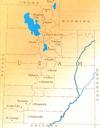By S. George Ellsworth Ensign, Oct. 1995, 30
Using a combination of faith and muscle, Latter-day Saint pioneers established homes, farms, and communities in the southwestern United States.
In November, Isaac Morley was called to preside over the proposed settlement. Some 224 persons were called by name from the pulpit to settle Sanpete Valley. No sooner had they arrived on 22 November 1849 than snow fell and a bitter-cold winter closed in on them.

President Brigham Young closed the Nephi, Utah, conference in central Utah in 1868 by reading the names of 154 men and their families called to strengthen settlements along the Muddy River, three hundred miles south of Nephi. Elizabeth heard only her father’s name and began to weep bitterly, tears spoiling the new white dress she had purchased with her earnings as a telegraph operator. Her friend said, “Why are you crying? My father has been called, too, but you see that I am not crying because I know he won’t go.†Elizabeth looked directly at her friend. “That is just the difference. I know that my father will go and that nothing will stop him.†1
Elizabeth’s father, Samuel Claridge, did go. Obedient to the call of a prophet, Brother Claridge labored on the Muddy until that mission was abandoned, then went on to pioneer three more settlements during his lifetime. Like many other early Latter-day Saint pioneers, he willingly sacrificed his possessions repeatedly, investing his holdings instead in the kingdom of God (see accompanying article, “Sacrificing for the Kingdomâ€).
Considered a test of faith, obedience to the call of the prophet by families such as the Claridges was a key to the success of Latter-day Saint pioneer settlement. President Brigham Young called faithful Saints to help establish new settlements just as the Prophet Joseph Smith had issued calls to certain members to help establish proselyting missions. Saints attributed calls to settle to divine inspiration. Everyone gave such calls serious consideration. Some with doubts declined to accept their calls. In time, thousands of members answered their calls and thus helped build up the kingdom of God on earth.
Some diarists noted their feelings upon being called to help found settlements: “This is the hardest trial I ever had,†wrote Charles L. Walker, “and had it not been for the Gospel and those placed over us, I should never had moved a foot to go on such a trip.â€
Christopher J. Arthur wrote, “I did not feel well over it for several weeks.†However, he went and served as stake president.
Elijah Averett returned home after a hard day in the fields to discover he had been called to Dixie (St. George). He dropped into a chair and said sternly that he wouldn’t go. But after a few minutes, he stood up and said, “Well, if we’re going to Dixie we’d better start to get ready.†2
Jesse N. Smith wanted to go on a colonizing mission, but he still made a great sacrifice in doing so. “In the fall of 1851, my brother and I were counselled … to settle at Parowan in Iron County. We prepared to move, … sold our city lot … , [and] were soon under way and stopped for the night … at Uncle John’s. … He wished me to remain and go to school at his expense. … Although I greatly desired to get an education, I preferred to go upon the mission.†3
Sanpete, 1850
The first distant outpost consisting of people who answered “the call†was in Sanpete Valley, 120 miles south of Salt Lake City, in nearby land of Ute Indian chief Walker. In June 1849, Chief Walker invited President Brigham Young to send settlers to teach the Utes how to farm and build. The invitation was accepted, the territory explored, and the project approved in the October general conference. In November, Isaac Morley was called to preside over the proposed settlement. Some 224 persons were called by name from the pulpit to settle Sanpete Valley. No sooner had they arrived on 22 November 1849 than snow fell and a bitter-cold winter closed in on them. In these circumstances, the settlers could not erect cabins or build a fort. The Indians, who initially had been so friendly, now turned unfriendly and demanded food. The settlers fed the Indians and saved them from starvation but greatly diminished their own food supplies. Measles spread among the people, taking the lives of several children.
On 20 February 1850, Isaac Morley wrote: “We have put up about twenty houses, but some of our people live in tents and in caves of the earth. The lines are measured off for a fort, but only a little work has been done on it. We have enough to do in tending fires and the cattle.†9
At last friendly Indians helped, and men were able to get to Salt Lake City and back on snowshoes, bringing much-needed supplies. In May ten teams with grain were sent from Salt Lake City to Sanpete. With the coming of spring, the settlers turned to plowing, planting, and building shelters and fences. Chief Walker showed his positive feelings for the Saints when on March 13 he was baptized. On 7 July 1850, Isaac Morley asked Chief Walker if some of his people wanted to be baptized, and 120 of the 250 were baptized.
When President Young visited the settlement, which he named Manti, in August 1850, surveyors marked out a city with eleven blocks, including a temple site. By the end of 1850, the settlement numbered 365 people.
As time passed and agricultural progress remained slow, many of the people became discouraged. But when President Young sent large companies of Scandinavian immigrants to Sanpete Valley, the outpost succeeded. In due time Sanpete became the granary of Utah. 10
10. Ibid., 4-8 Aug. 1850, 6-8 Sept. 1850, 19 July 1853, 7 Oct. 1853.
Comments are closed.